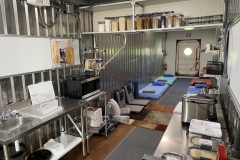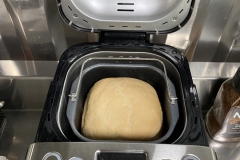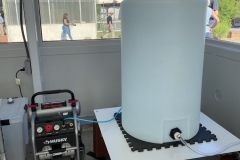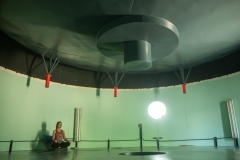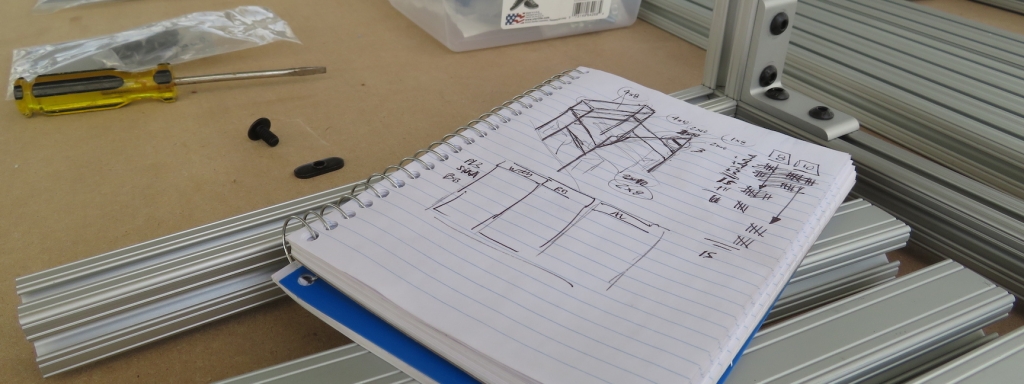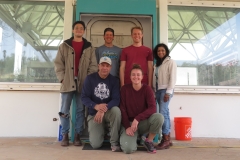It’s all coming together
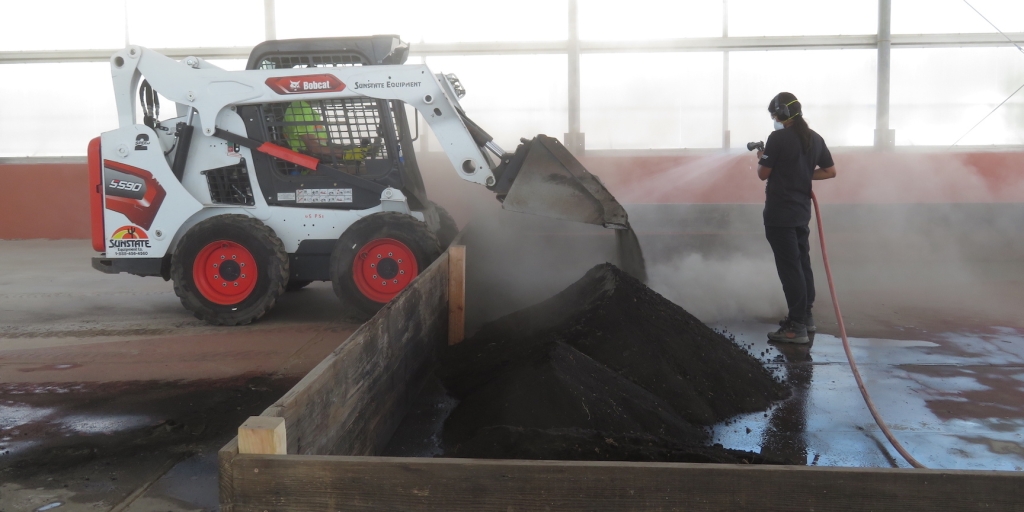
We continue with avid construction of SAM in preparation for receipt of our first visiting research teams. We are working sunrise to sunset with projects completed daily. Each week in review sees “TODOs” transform into “DONEs”. Evenings are time for communication with the first two teams to visit SAM, a review of their proposed mission plans, research objectives, and many details in preparation for the first sealed, pressurized experiment at Biosphere 2 in thirty years.
In brief, we have complete the installation of the fully networked, computer controlled fire detection and alarm system, all wiring throughout the habitat, installation of our fourth and final mini-split A/C unit, all plumbing including potable water storage, gray water recycling, and waste water containment is complete. Sean has constructed the prototype inner door of the airlock, and we are eager for the first pressure test.
Atila and Kai upgraded one of the hydroponics racks from last year for an improved water flow and reduced algae build-up. This is centerpiece to Atila’s PhD research at the University of Arizona under the direction of Dr. Gene Giacomelli at CEAC. By no means the final product, this prototype will serve us well for the coming two missions. Lettuce is installed and water nutrients added. John Z. returned for a Saturday morning to assist with the final mini-split install, and Colleen rejoined the team for a few days, lending her keen eye for detail and experience with fabrication.
The Mars yard too has seen a completely transformation from our workshop for the past two years into a functional, prototype test bed for pressure suits, tools, and drones. Tasha and Matthias assembled a barrier to contain the crushed basalt (a close facsimile to Martian soil) and then retraced the original Biosphere 2 rain forest walkway with a fresh coat of Mars-red paint.
The lung is now fully refurbished, complete with a variable frequency drive, electric actuated valve, and a new set of legs for a more stable touch-down and ease of measuring height from the lung floor.
The SIMOC Live server is fully operational with support for a variety of Vernier and Adafruit sensors, and our light-travel time delay server will soon be deployed, providing the limited internet (email only) for visiting research teams, communications delay by 1.3s to the Moon, or 7-20 minutes for Mars.
Fire detection system nearly complete
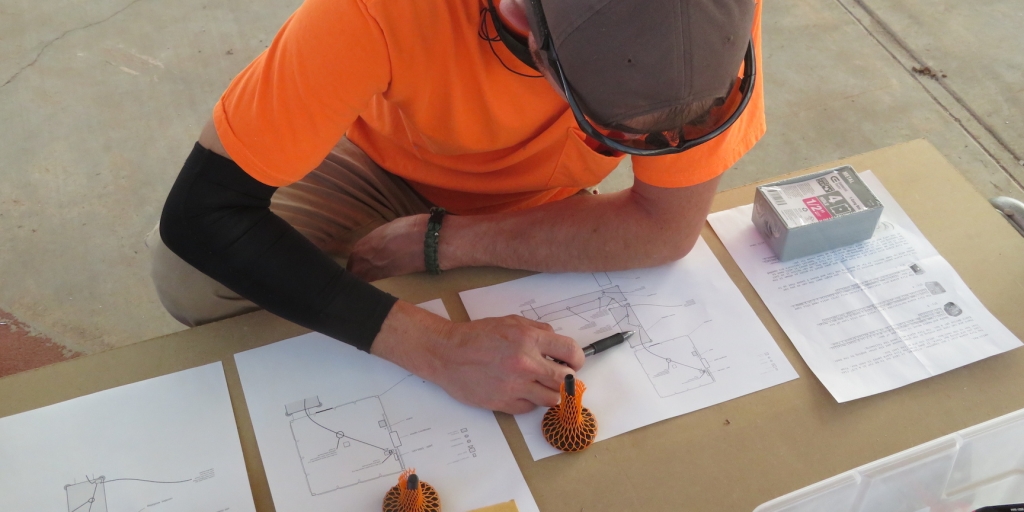
When we first reached out to the University of Arizona Facilities Management Electrical Services, Fire Safety & Prevention Assistant Director Joseph Branaum for guidance on how to design and install the fire detection system at SAM, we were concerned that the unique nature of our research facility might invoke a high degree of scrutiny. While the vessel is built from steel, aluminum, and glass with very limited flammable materials inside, the fact that four people will be sealed inside with pressure hatches as exits could have raised alarm.
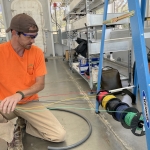 The first two teams to SAM will each have one blind crew member. This elevates the need for our fire detection and alarm system, beyond off-the-shelf, battery powered smoke detectors available from local resellers. Instead, SAM must integrate a fully networked, computer controlled system that raises audible and visual alarms across the habitat should any of the heat or smoke detectors be triggered. Furthermore, each exit must have an illuminated sign in the case of a power outage. We are taking that one step further, to make certain that each pressure hatch is fully lit with power loss, such that crew members can readily assist each other in egress, emergency or not.
The first two teams to SAM will each have one blind crew member. This elevates the need for our fire detection and alarm system, beyond off-the-shelf, battery powered smoke detectors available from local resellers. Instead, SAM must integrate a fully networked, computer controlled system that raises audible and visual alarms across the habitat should any of the heat or smoke detectors be triggered. Furthermore, each exit must have an illuminated sign in the case of a power outage. We are taking that one step further, to make certain that each pressure hatch is fully lit with power loss, such that crew members can readily assist each other in egress, emergency or not.
Joe visited SAM in February and immediately recognized the need for a fire detection system that met the University safety guidelines and upheld the need for SAM to closely approximate an actual, other-world habitat. He designed a system that meets code and serves our needs.
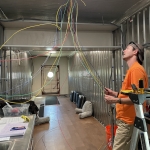 What’s more, the entire system will be upgraded later in 2023 to include active data generation and capture for real-time temperature, humidity, and air quality, then integrated into the SIMOC Live terminal at SAM, thereby elevating the SAM analog experience even closer to that of a real habitat while further informing the SIMOC model.
What’s more, the entire system will be upgraded later in 2023 to include active data generation and capture for real-time temperature, humidity, and air quality, then integrated into the SIMOC Live terminal at SAM, thereby elevating the SAM analog experience even closer to that of a real habitat while further informing the SIMOC model.
Joe and his associate Matt have guided the complex wiring of this system, and will return to SAM for the final installation of the pull stations, A/V units, and detectors. Thank you Joe and Matt for your patience with our 100+ questions, phone calls, text messages, and emails.
We’ve got the power!
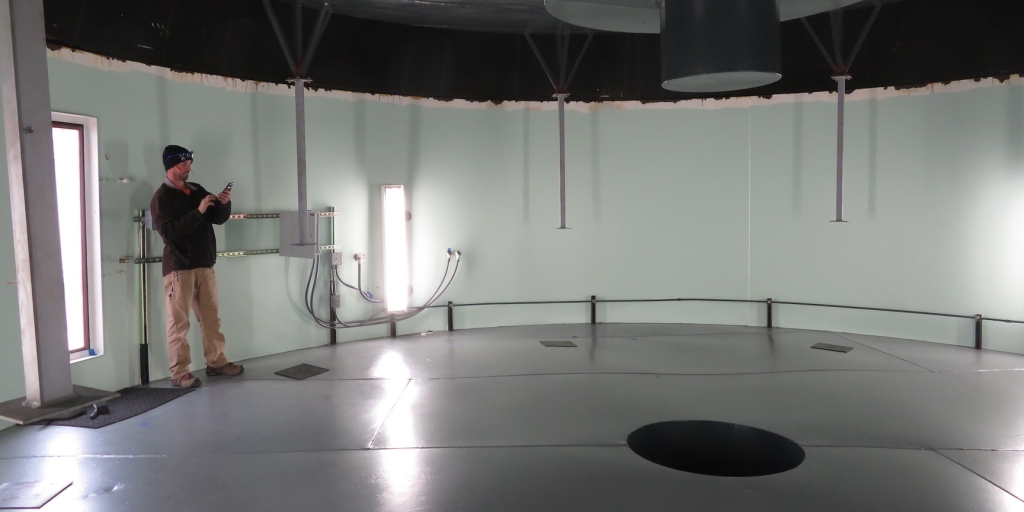
Today we completed the electrical wiring of SAM, with the Workshop (20′) and Crew Quarters (40′) fully lit up and operational. We also conducted our first pressure test since January, and with the new 1HP Variable Frequency Drive. We can now bring SAM from ambient to full pressure in just under 3 minutes, a 4x speed increase over the original, 1980s blower which is now replaced.
This is a noteworthy and exciting day, for it marks months of sequential work come to fruition.
Comfort in simple things
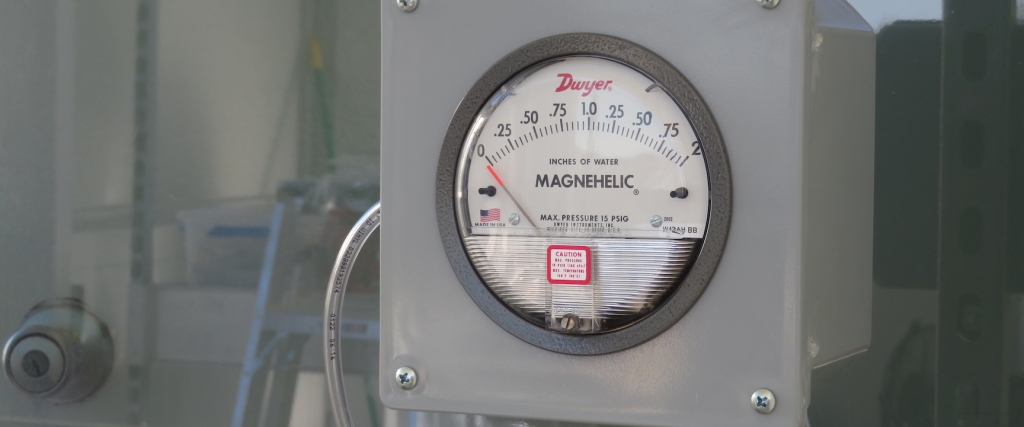
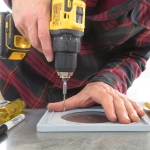 There are those simple devices that defy the mindless trend toward smaller, smarter, and digital. The phonograph is back to stay, with more vinyl records being produced today than at any time history. A good pocket knife is an indispensable tool for anyone who lives and works outdoors. And the harmonica is a light, portable instrument able to warm the hearts of all who listen or sing along — without batteries, USB, WiFi, or Siri selling your private conversation to the highest bidder. They just work.
There are those simple devices that defy the mindless trend toward smaller, smarter, and digital. The phonograph is back to stay, with more vinyl records being produced today than at any time history. A good pocket knife is an indispensable tool for anyone who lives and works outdoors. And the harmonica is a light, portable instrument able to warm the hearts of all who listen or sing along — without batteries, USB, WiFi, or Siri selling your private conversation to the highest bidder. They just work.
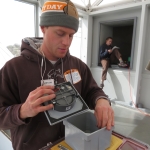 The analog pressure gauge is a simple, elegant, analog instrument. It will function for a hundred years or more, providing reliable data with little potential for failure.
The analog pressure gauge is a simple, elegant, analog instrument. It will function for a hundred years or more, providing reliable data with little potential for failure.
At SAM, visitors both inside and out must know, without a doubt, if the vessel is under pressure. For those on the outside, opening the hatch while under pressure could mean getting catapulted across the Mars yard, or worse. For those on the inside, a rapid depressurization should only be conducted in the case of an emergency and need for immediate egress.
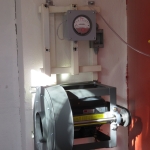
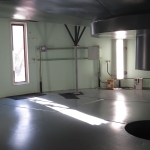 This particular Dwyer Magnehelic was selected for its 0-2 inches of water callibration, giving the highest accuracy for the maximum of 0.05 PSI over ambient pressure differential at SAM. We liked it so much, we installed five (for now): inside and outside the Test Module emergency exit; inside the exterior airlock door, inside the SAM Air Intake Room (AIR) just above the new blower, and on a new instrument wall on the interior wall of the lower SAM lung.
This particular Dwyer Magnehelic was selected for its 0-2 inches of water callibration, giving the highest accuracy for the maximum of 0.05 PSI over ambient pressure differential at SAM. We liked it so much, we installed five (for now): inside and outside the Test Module emergency exit; inside the exterior airlock door, inside the SAM Air Intake Room (AIR) just above the new blower, and on a new instrument wall on the interior wall of the lower SAM lung.
No matter which room a crew member occupies, the pressure will be visibly displayed. And for those visiting from the outside, a quick look to the large interface will make it clear if it is safe to enter.
Power and the Bridge
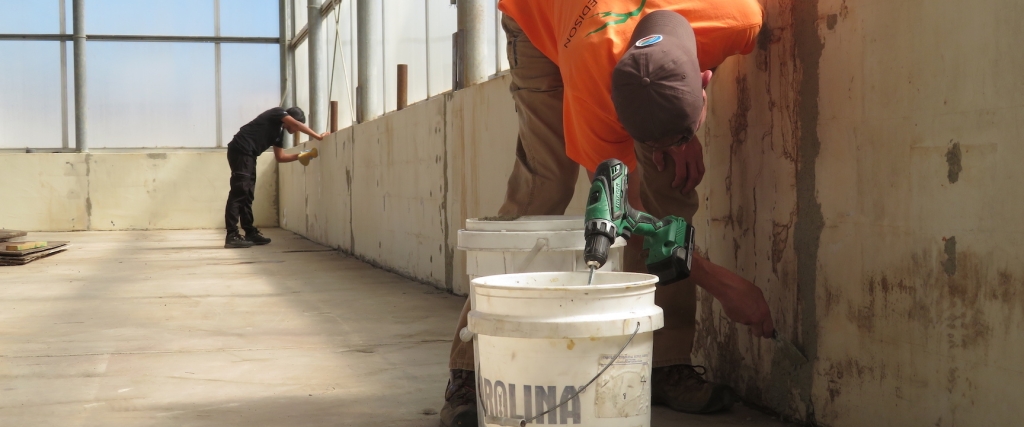
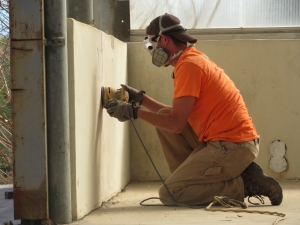 In early 2023 the SAM project received its first round of funding dedicated to the renovation of the former Biosphere 2 rain forest greenhouse into a 6,400 sq-ft indoors Mars yard. The University of Arizona center for Research, Innovation, and Impact (RII) sees significant value in the creation of an advanced Mars yard, a place for education, research, and innovation.
In early 2023 the SAM project received its first round of funding dedicated to the renovation of the former Biosphere 2 rain forest greenhouse into a 6,400 sq-ft indoors Mars yard. The University of Arizona center for Research, Innovation, and Impact (RII) sees significant value in the creation of an advanced Mars yard, a place for education, research, and innovation.
Significant prior effort had been applied, from initial destruction of adjacent structures to tearing down the old roof panels; from work on the exterior walls to installing a new roof.
Now, we are continuing to renovate the structure, starting at the foundation walls. Once complete, we can design our first basic layout, install basalt left over from the LEO project, and place varied boulders (even if not igneous based) to form a terrain park for our first, visiting research teams.
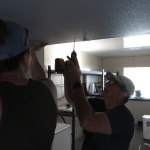 In parallel, fabrication of the interior of SAM continues, with immediate focus on completing the electrical panel, UA approved smoke and fire detection system, and routing conduit and circuits to the bathroom, kitchen, and crew quarters.
In parallel, fabrication of the interior of SAM continues, with immediate focus on completing the electrical panel, UA approved smoke and fire detection system, and routing conduit and circuits to the bathroom, kitchen, and crew quarters.
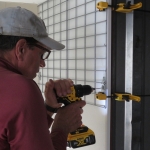 In order to bring power into the renovated 40′ shipping container, we must route Carflex conduit through one of two pressure hull bridges. This invokes a bottle neck as this is a passage the crew will use regularly as they move from the crew quarters into the workshop and subsequent Test Module (controlled environment for plant growth). As such, it is imperative that the conduit be non-intrusive and secured.
In order to bring power into the renovated 40′ shipping container, we must route Carflex conduit through one of two pressure hull bridges. This invokes a bottle neck as this is a passage the crew will use regularly as they move from the crew quarters into the workshop and subsequent Test Module (controlled environment for plant growth). As such, it is imperative that the conduit be non-intrusive and secured.
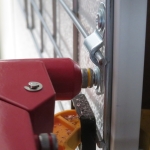 Given that we cannot penetrate any wall surface that holds pressure, we must carefully select the structure elements able to receive a bolt, metal screw, or rivet. We were able to reuse two former steel shelf grids, reduced in size, as a means to secure electrical conduit to the wall in such a way that it can be readily adjusted, even moved in the future.
Given that we cannot penetrate any wall surface that holds pressure, we must carefully select the structure elements able to receive a bolt, metal screw, or rivet. We were able to reuse two former steel shelf grids, reduced in size, as a means to secure electrical conduit to the wall in such a way that it can be readily adjusted, even moved in the future.
Everything, everywhere, all at once
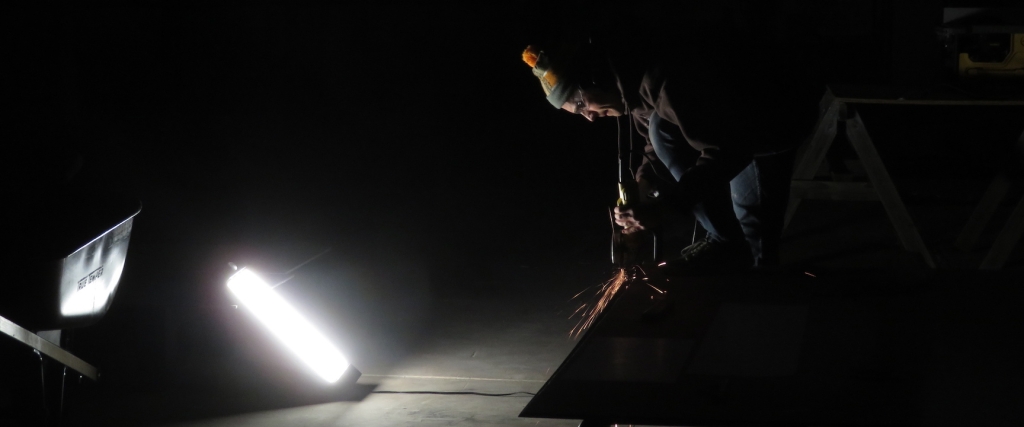
This past two weeks has seen a number of disparate tasks completed in parallel.
The two decades old shipping container serving as our Crew Quarters was designed to be air tight but not to hold pressure over time. This is compounded by skirmishes with forklifts that resulted in a few patches, bowed panels, and disconnected interfaces. As we have this past six months repaired the major leaks, smaller holes have been exposed. Our most recent pressure test discovered a leak at the overlapping seam between the stainless steel frame and aluminum ceiling roll at the back of the 40′ shipping container. Kai removed the failed rivet and drew open the enveloped just wide enough to inject 795 silicone. A new rivet drew the the interface tight again. Bindhu then scraped and cleaned the entire interface that spans the width of the container, followed by an application of aluminum tape with assistance from John Z. The entire perimeter of the wall-to-ceiling interface is now complete.
Kai and Sean worked to prepare for the installation of the electrical sockets in the workshop (20 foot container) with fabricated aluminum plates to give strength to the in-house designed, modular wall mount system. Subsequently, three 20 amp electrical circuits were installed. The original, exterior steel door to the Test Module was removed last fall, sanded, primed, and recently top-coated with Rust-Oleum white enamel paint, the same that now protects the entire exterior of the refurbished shipping containers and airlock. With new, steel bearing hinges, the door was replaced and is incredibly smooth in its operation, ready for three more decades of service.
Following several applications of PB Blaster over the prior week, Kai and John Z attempted (in vain) to remove an old “J” pipe fitting on the exterior of the B2 airlock installed at SAM last year. The 4 foot, 30 lbs wrench was apparently not large enough, and in the end the fitting was cut free, the remnant filled with foam, to be capped and sealed soon.
Arizona State University undergraduate student and new volunteer at SAM Tasha Coelho applied diligent attention to the final effort in restoration of the original Test Module lung. She scraped free all loose paint and then hand-sanded the underbelly of the pan in preparation for a coat of Rust-Oleum primer. Luna then applied two coats of a beautiful, dark blue-grey semi-gloss enamel.
Sean and our new volunteer Matthias Beach tackled the installation of the new variable frequency drive (VFD) blower to inflate the lung and pressurize SAM. Matthias is a Former Air Force Computer and Switching Systems Specialist and citizen telecommunications field service specialist who brings skills in construction, electrical wiring, and equipment operation to this endeavor at a critical time. The VFD motor is 1 HP (as compared to the former blower of 1/3 HP) with a significantly larger blower which will result in our ability to inflate SAM in far less time than the former 15 minutes, and with the variable speed control, maintain a constant, minimal influx of air for those teams preferring to run SAM in either of the two pass-through modes.
In the midst of our third snow storm this winter, Matthias, Sean, Tasha, and Luna completed the wiring of the Test Module that was begun last year, with eight 20 amp circuits ready to handle the most arduous of hydroponic racks.


